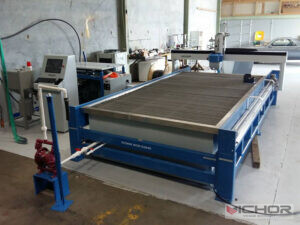
Water Jet Precision: How It Delivers Unmatched Accuracy in Modern Cutting Applications
In the realm of industrial manufacturing, accuracy isn’t just a goal—it’s a necessity. Imagine a tool that can slice through titanium, glass, or composite materials with the finesse of a surgeon’s scalpel, all without generating heat or leaving behind imperfections. This is the reality of water jet cutting, a technology where water jet precision takes center stage. As industries evolve toward more complex designs and tighter tolerances, understanding the nuances of water jet precision becomes crucial for engineers, designers, and business leaders alike. This article dives deep into the core aspects of water jet precision, shedding light on why it’s a game-changer in sectors ranging from aerospace to artisanal crafts. By focusing on the mechanisms, benefits, and real-world applications, we’ll explore how this precision-driven approach is reshaping production floors and pushing the boundaries of what’s possible. Whether you’re new to the concept or seeking to optimize its use, the following sections will provide a comprehensive look at the elements that define water jet precision and its transformative impact.
What is Water Jet Precision and Why Does It Matter?
Water jet precision refers to the exceptional accuracy and control achieved in water jet cutting processes, where a high-pressure stream of water—often mixed with abrasive materials—is used to cut, shape, or engrave various substances. This precision is measured in terms of tolerances, typically ranging from ±0.003 to ±0.005 inches, allowing for intricate designs and clean edges without thermal distortion. In essence, water jet precision ensures that cuts are made exactly as specified in digital designs, minimizing material waste and reducing the need for secondary finishing. This level of accuracy is vital in industries where even minor deviations can lead to costly errors or safety risks. For instance, in medical device manufacturing or automotive engineering, water jet precision enables the production of components that fit seamlessly into larger assemblies. Beyond technical specifications, water jet precision embodies a shift toward sustainable manufacturing by optimizing resource use. As demands for customization and efficiency grow, the importance of water jet precision continues to rise, making it a cornerstone of modern fabrication techniques.
The Mechanics Behind Achieving Water Jet Precision
The foundation of water jet precision lies in its sophisticated operational mechanics, which combine high-pressure systems, advanced nozzle design, and computer-controlled guidance. Typically, water is pressurized to levels exceeding 60,000 psi and forced through a small orifice, creating a focused jet that travels at speeds near Mach 3. When abrasives like garnet are added, this jet gains the ability to cut through hard materials such as metals or ceramics. Key to maintaining water jet precision is the use of CNC (Computer Numerical Control) systems, which translate digital blueprints into precise movements of the cutting head. This ensures consistent accuracy across multiple parts, even in complex geometries. Additionally, factors like nozzle wear, water purity, and pressure stability play critical roles in upholding water jet precision. Regular calibration and monitoring help mitigate variations, ensuring that the jet remains aligned with intended paths. By integrating real-time feedback mechanisms, modern systems can adjust parameters on the fly, further enhancing water jet precision in dynamic environments. This mechanical synergy allows for repeatable results, making it a reliable choice for high-stakes applications.
Key Advantages of Water Jet Precision in Industrial Applications
One of the most compelling aspects of water jet precision is its array of benefits, which extend beyond mere cutting accuracy. First, it eliminates heat-affected zones (HAZ), a common issue in laser or plasma cutting that can alter material properties. This cold-cutting process preserves the integrity of materials like plastics or heat-sensitive alloys, ensuring that water jet precision delivers flawless results without thermal stress. Second, water jet precision supports versatility, as it can handle a wide range of materials—from soft rubber to hardened steel—without requiring tool changes. This flexibility reduces setup times and costs, boosting overall productivity. Third, environmental considerations come into play; water jet precision minimizes waste by enabling nested cutting patterns that optimize material usage. Moreover, it often uses recycled water and natural abrasives, aligning with green manufacturing practices. Fourth, the precision reduces the need for post-processing, as cuts are clean and burr-free, saving time and labor. Finally, water jet precision enhances safety by avoiding sparks or fumes, making it suitable for hazardous environments. These advantages collectively make water jet precision a cost-effective and efficient solution for diverse industrial needs.
Applications Where Water Jet Precision Shines
Water jet precision finds its place in a multitude of industries, each leveraging its accuracy for specific challenges. In aerospace, for example, components like turbine blades or composite panels require exact tolerances to ensure performance and safety; water jet precision allows for cutting these parts without compromising their structural integrity. The automotive sector uses it for prototyping and producing intricate parts like gaskets or custom trim, where consistency is key. In architecture and design, water jet precision enables the creation of detailed patterns in stone, glass, or metal for artistic installations and functional structures. The food industry even employs it for cutting products like pastries or frozen goods with hygienic, precise edges. Additionally, in electronics manufacturing, water jet precision is used to shape delicate circuits or insulation materials without causing electrostatic damage. These applications demonstrate how water jet precision adapts to various demands, providing solutions that balance creativity with technical rigor. As technology advances, new fields like renewable energy and medical implants are also embracing water jet precision for its ability to handle innovative materials with utmost accuracy.
Factors Influencing and Enhancing Water Jet Precision
Achieving optimal water jet precision depends on several factors, each requiring careful management. Pressure consistency is paramount; fluctuations in the high-pressure pump can lead to variations in cut quality, so maintaining stable pressure levels is essential for reliable water jet precision. Nozzle design and condition also play a critical role—wear and tear can cause the jet to diverge, reducing accuracy. Regular inspection and replacement of nozzles help sustain water jet precision over time. The choice of abrasive material and its flow rate affects cutting speed and edge quality; finer abrasives often enhance water jet precision in delicate tasks. Water quality, including filtration to remove impurities, ensures a consistent stream free from obstructions. Furthermore, software and control systems contribute significantly; advanced CAD/CAM integrations allow for precise path planning and error correction, directly impacting water jet precision. Operator expertise is another factor, as skilled technicians can adjust parameters like traverse speed or standoff distance to optimize results. By addressing these elements, businesses can continually improve water jet precision, adapting to evolving project requirements.

The Future of Water Jet Precision: Trends and Innovations
As technology progresses, water jet precision is poised to reach new heights through innovations in automation, material science, and data analytics. The integration of AI and machine learning, for instance, could enable predictive adjustments in real-time, further refining water jet precision by anticipating issues like material variations or nozzle wear. Developments in ultra-high-pressure systems may push tolerances even tighter, expanding the scope of water jet precision to nano-scale applications. Sustainability trends are driving the adoption of greener abrasives and water recycling methods, ensuring that water jet precision aligns with circular economy principles. Moreover, the rise of hybrid systems combining water jets with other technologies, such as lasers, could offer multi-functional precision capabilities. These advancements will likely make water jet precision more accessible and efficient, fostering its use in emerging fields like additive manufacturing or biomedical engineering. By staying at the forefront of these trends, industries can harness water jet precision to tackle future challenges, from customizing consumer products to advancing space exploration.
In summary, water jet precision represents a fusion of engineering excellence and practical innovation, offering a reliable path to superior cutting outcomes. Its ability to deliver accuracy across diverse materials and applications makes it an invaluable asset in today’s manufacturing landscape. As we’ve seen, from its mechanical underpinnings to its future potential, water jet precision continues to evolve, setting new standards for quality and efficiency. By embracing this technology, businesses can not only enhance their operational capabilities but also contribute to a more sustainable and precise industrial future.
Frequently Asked Questions
Q1: What materials can be cut with water jet precision?
A1: Water jet precision can handle a wide variety of materials, including metals like steel and aluminum, composites, glass, stone, ceramics, plastics, and even sensitive materials such as foam or food products. The key is that water jet precision avoids heat damage, making it suitable for heat-sensitive substances.
Q2: How does water jet precision compare to laser cutting in terms of accuracy?
A2: While both methods offer high accuracy, water jet precision typically excels in applications involving thick materials or those prone to heat damage, as it maintains tolerances without thermal distortion. Laser cutting might achieve slightly finer details in thin materials but can introduce heat-affected zones, whereas water jet precision provides a cold-cutting alternative with consistent results across diverse thicknesses.
Q3: What is the typical tolerance range for water jet precision?
A3: The tolerance for water jet precision generally falls between ±0.003 inches and ±0.005 inches, though advanced systems can achieve even tighter tolerances under optimal conditions. This range ensures precise cuts for most industrial applications, reducing the need for additional machining.
Q4: Can water jet precision be used for 3D cutting or complex shapes?
A4: Yes, water jet precision is highly capable of 3D cutting and intricate shapes due to its CNC-guided systems. The cutting head can be maneuvered along multiple axes, allowing for bevels, contours, and complex geometries while maintaining accuracy, making it ideal for prototypes and custom designs.
Q5: How do maintenance requirements impact water jet precision?
A5: Regular maintenance is crucial for sustaining water jet precision; this includes inspecting and replacing worn nozzles, ensuring consistent water pressure, and cleaning abrasive delivery systems. Neglecting maintenance can lead to reduced accuracy, increased wear, and higher operational costs, so adherence to scheduled upkeep helps preserve optimal performance.
continue reading
Related Posts
- 1352 words6.8 min read
- 1378 words6.9 min read


